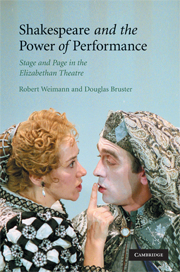Book contents
- Frontmatter
- Contents
- Acknowledgments
- Introduction
- Chapter 1 “Moralize two meanings” in one play: contrariety on the Tudor stage
- Chapter 2 Performance, game, and representation in Richard III
- Chapter 3 Mingling vice and “worthiness” in King John
- Chapter 4 Clowning: agencies between voice and pen
- Chapter 5 Clowning at the frontiers of representation
- Chapter 6 Cross-dressing and performance in disguise
- Chapter 7 Personation and playing: “secretly open” role-playing
- Chapter 8 Character/actor: the deep matrix
- Chapter 9 Character: depth, dialogue, page
- Chapter 10 King Lear: representations on stage and page
- Notes
- Index
- References
Chapter 9 - Character: depth, dialogue, page
Published online by Cambridge University Press: 22 September 2009
- Frontmatter
- Contents
- Acknowledgments
- Introduction
- Chapter 1 “Moralize two meanings” in one play: contrariety on the Tudor stage
- Chapter 2 Performance, game, and representation in Richard III
- Chapter 3 Mingling vice and “worthiness” in King John
- Chapter 4 Clowning: agencies between voice and pen
- Chapter 5 Clowning at the frontiers of representation
- Chapter 6 Cross-dressing and performance in disguise
- Chapter 7 Personation and playing: “secretly open” role-playing
- Chapter 8 Character/actor: the deep matrix
- Chapter 9 Character: depth, dialogue, page
- Chapter 10 King Lear: representations on stage and page
- Notes
- Index
- References
Summary
During Shakespeare's lifetime, a vitalized print culture affected London's theatrical scene greatly. Making broad headway into the still strong culture of orality and storytelling, the “paper-sea” that John Florio noticed with some amazement left lasting marks on dramatic output and form. That print did so even as it drew energy from the regular performances at the purpose-built playhouses testifies to the close relationship the two media shared. While we are used to thinking of stage and page in fairly linear ways – printed sources, for example, leading to theatrical narratives that in turn form the basis for printed dramatic texts – there is good reason, as Barbara Mowat has argued, for understanding the “relationships among performance, playscript, and printed text” as “more fluid, more disturbed, than scholars have tended to imagine and describe them.” From such examples as the complicated material life of the Pericles story, 1607, and the testimony of Sir Richard Cholmeley's Players, in 1611, that they had performed only what was available in “the printed booke,” to the evidence, in the later Douai Shakespeare manuscripts, of “playtexts that have transmigrated from printed texts annotated for performance into manuscript playbooks,” it is clear that the connections between stage and page were dynamic, and resist univocal pronouncements concerning the directions or duration of agency.
We have already seen how the striking physical ensemble of a clowning, “self-misformed lout” had migrated from the boards of the stage to Joseph Hall's satirical page in 1597's Virgidemiarum (see above, pp. 111–12).
- Type
- Chapter
- Information
- Shakespeare and the Power of PerformanceStage and Page in the Elizabethan Theatre, pp. 178 - 198Publisher: Cambridge University PressPrint publication year: 2008



